Occupational Dermatoses in Parachute Riggers: A Cross-Sectional Observational Study
Abstract
Background
Parachute riggers are specialised tradesmen involved in packing parachutes. Occupational dermatoses have never been studied in them despite their job entailing hard manual work.
Objectives
To observe, diagnose, record and characterise various hand and nail changes and diseases in parachute riggers.
Methods
Parachute riggers working at Paratrooper Training School (PTS), Agra, India, consenting to participate in the study were enrolled. A brief history and hand and nail changes seen using a hand-lens were recorded. Data were analysed using R-Project for Statistical Computing version R 3.6.2 for Windows.
Results
A total of 76 participants were examined. The mean age was 29.6 years and the mean duration of employment was 29.7 months. All were males. Callosities and loss of cuticle were the commonest abnormalities present in 61 (80.2%) and 57 (75%) participants, respectively. Other common changes were pitted scars 24 (31.5%), xeroderma 23 (30.2%), pigmentary changes 21 (27.6%), onychoschizia 10 (13.1%) and splinter haemorrhages 5 (6.5%). The most common diseases observed were dermatitis (21%) and onychomycosis. The odds ratio for occurrence of callosities decreased with age (OR 0.889, 95% CI 0.825–0.957, p = 0.002). Spearman's rank coefficient of correlation showed a statistically significant negative association between the number of hand and nail changes observed and duration of employment (Spearman's ρ = − 0.25, p = 0.03).
Conclusion
Most of the changes observed were secondary to repeated friction, pressure and dryness of hands. Emphasising adequate corrective measures involving barrier creams, good quality gloves and health education may significantly reduce the incidence of these changes.

 求助内容:
求助内容: 应助结果提醒方式:
应助结果提醒方式:


